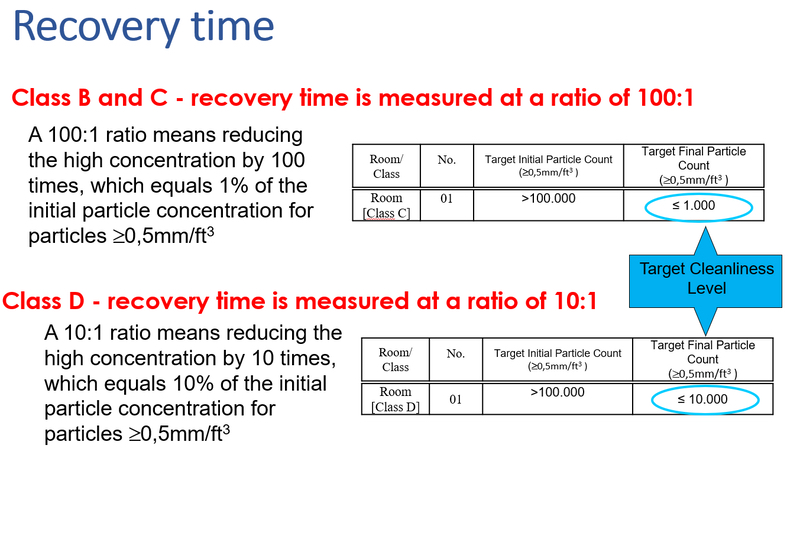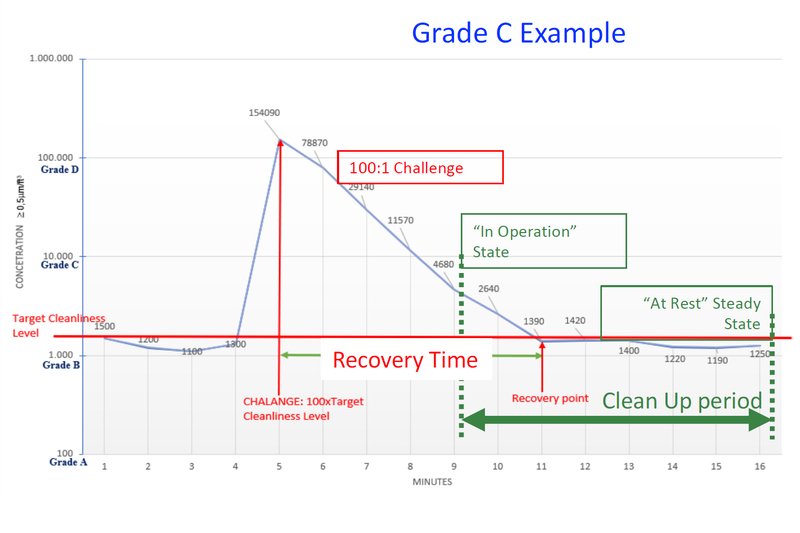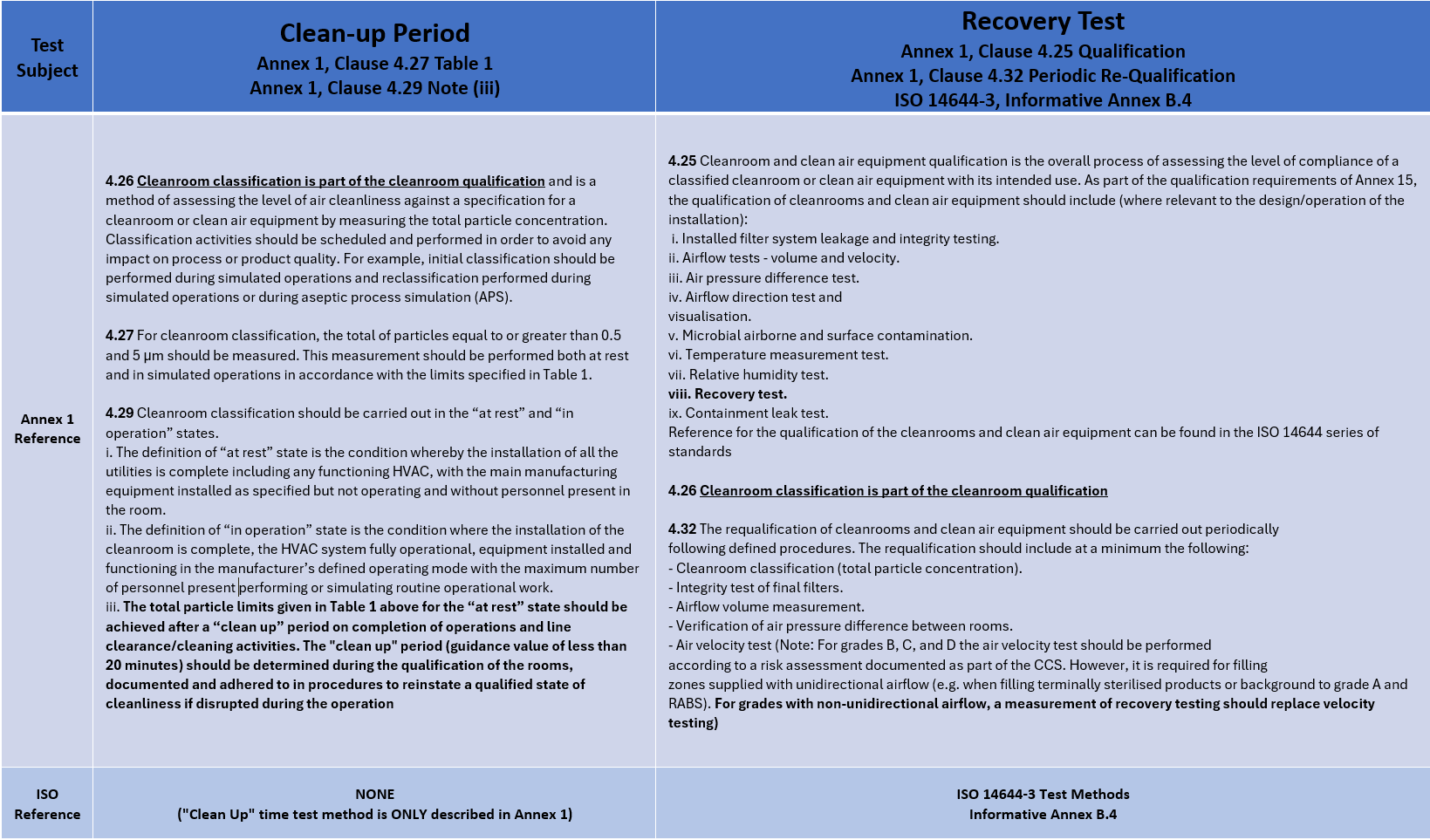Introduction
With the implementation of the new Annex 1, and references to the ISO 14644 family of cleanroom standards, comprehensive guidelines have been established for the design and demonstrating GMP-compliant operation of cleanrooms and their HVAC systems.
However, these guidelines often lead to practical questions about the "Recovery time" and the "Clean-up period":
- Are these distinct requirements, or are they identical?
- Do they apply only to sterile products, or do they also cover non-sterile medicinal products?
- Should these measurements be taken during “In Operation” or when the cleanroom is in the “At Rest” state?
We will address these questions and we present a graphical illustration as well as a comparative table to help understand the differences and application of these two important tests.
Historical context
By way of some background information Clean-up periods have always been an important consideration in Annex 1:
-
Notes from the 2008 version of Annex 1: "The particle limits given in the table for the 'at rest' state should be achieved after a short 'clean up' period of 15-20 minutes (guidance value) in an unmanned state after completion of operations."
-
Notes from the 2003 version of Annex 1: "The particulate conditions given in the table for the 'at rest' state should be achieved after a short 'clean up' period of 15-20 minutes (guidance value) in an unmanned state after completion of operations. The particulate conditions for grade A 'in operation' given in the table should be maintained in the zone immediately surrounding the product whenever the product or open container is exposed to the environment. It is accepted that it may not always be possible to demonstrate conformity with particulate standards at the point of fill when filling is in progress, due to the generation of particles or droplets from the product itself."
Clean-up period as per Annex 1 from August 2023
The Clean-up period is defined in Clause 4.29 Note (iii) of the new Annex 1 from August 2023: “The total particle limits given in Table 1 above for the “at rest” state should be achieved after a “clean up” period on completion of operations and line clearance/cleaning activities.
The Clean-up period is defined in Clause 4.29 Note (iii) of the new Annex 1 from August 2023
The "clean up" period (guidance value of less than 20 minutes) should be determined during the qualification of the rooms, documented and adhered to in procedures to reinstate a qualified state of cleanliness if disrupted during operation.”
Just to be clear then, the Clean-up period is measured starting from the operating state, i.e. "In Operation" and ends at the “At Rest" state, i.e. after “Elvis has left the building“! So, is the time taken for the airborne particle concentration levels to return the cleanroom to At Rest conditions, after people have left the room.
Recovery time
The Recovery time is a requirement of ISO 14644. The recovery test is conducted to determine whether the cleanroom can return to its specified cleanliness class within a limited period after brief exposure or challenge to a source of airborne particles.
According to ISO 14644-3, the necessary reduction of the initial particle concentration is specified as either 1:100 (ISO 7 At Rest, i.e. Grade B In Operation or Grade C At Rest) or 1:10 (ISO 8, i.e. Grade D At Rest).
The initial particle concentration should be elevated to more than 10 or 100 times the target level, which can be the design cleanliness level, the level defined by ISO 14644-1 in the 'at-rest' condition, or an agreed alternative cleanliness level.
For instance, the 100:1 recovery test method measures the time needed for the cleanroom to return to its target cleanliness level after an aerosol challenge 100 times that level.
The Recovery time is a requirement of ISO 14644
The goal is to perform the recovery test while minimizing contamination from the test itself.
It is acceptable to choose a target cleanliness level as low as possible, ideally higher than the particle baseline but not exceeding 1.5 times the particle baseline.
This approach allows the recovery test to be conducted without compromising the cleanroom with excessively high particle concentrations.
Alternate target cleanliness level
Recovery time

Figure 1: Distinguishing Recovery Time Ratios for Class B, C, and D
The recovery test is always carried out in the unmanned state after particles (the challenge) have been introduced.
A recovery test is a measurement of the effectiveness of the cleanroom's HVAC system to recover after an adverse event, incident or planned maintenance, and ensure a rapid return to a target level.
The Recovery time also provides information on the optimum door interlock time duration in airlocks (PALs and MALs).
There is no normative requirement for a specific Recovery time
It is recommended not only for production rooms but for all rooms with turbulent dilution flow, i.e. non-unidirectional airflow.
However, it is not recommended for unidirectional airflow rooms (low-turbulence displacement flow); the air velocity test is recommended instead.
There is no normative requirement for a specific Recovery time; each company is responsible for defining it. The confusion often arises because it is assumed the Recovery time should also be the same, i.e. “Less than 20 minutes.”
Comparative Graph and Table
The graph gives an illustration and the comparative table below helps explain in detail the subtle differences and nuances between these two very different but similar tests.

Graph 1: Graphic representation of the difference between Recovery Test and Clean-Up Period

Table 1: Comparative overview of Recovery Test and Clean-Up Test according to Annex 1 and ISO 14644-3

Table 2: Comparison of recovery and Clean-up Tests
Clean-up period - purpose and procedure
The purpose of this test is to determine the “clean-up” period for new or modified cleanrooms (Grades B, C and D).
The Clean-up test ensures that the cleanroom is capable of self-cleaning, meaning that the cleanroom can re-establish total particle concentration after “in operation” or “simulated operation” activities (when people leave the room) to the “at rest” level in a certain time (guidance value is less than 20 minutes).
Both the Clean-up period and Recovery time are crucial for demonstrating the effectiveness of the CCS
It is recommended that the clean-up test should replace the recovery test during periodic re-qualification activities, when the risk of introducing an aerosol challenge, acting as unnecessary contamination and residues is considered as too great.
This test is a “hybrid” test starting in the “in operation” state and finishing once the steady “at rest” state is achieved.
This test demonstrates continued cleanroom classification compliance to retain active and sufficient flushing of the cleanroom. The test procedure can be adopted as well for routine monitoring.
Clean-up test procedure:
-
Determine the identification and location of the sampling points (e.g., from an airflow visualization study or determine the worst case from process understanding based on risk assessment or the same location as defined for the Recovery time test).
-
Measure baseline particle levels for both ≥ 0.5µm and ≥ 5.0µm while in the “normal” or “simulated” operation state and keep measuring equipment running after the process stops or personnel leave the cleanroom.
-
Plot each minute of data until normal baseline values for the “at rest” state have been reestablished.
-
The Clean-up period is the time between the “in operation” state when operational activities stop and personnel leave the room until the steady “at rest” level is reached.
Application to non-sterile products:
While the new Annex 1 applies to the production of sterile medicinal products, it is increasingly referenced in the production of non-sterile products.
This is particularly sensible in the production of solid dosage forms, where the product itself is micronized particles.
The risk here is avoiding cross-contamination during a product change-over, where manufacturing equipment, and all room surfaces must also be cleaned before a new product is produced.
It is crucial to know how long the HVAC system needs to return to the “clean” (At Rest) state again. The Clean-up period is determined for airborne particle cleanliness classes, ISO 7 and ISO 8, associated with Grades B, C, and D (not for Grade A).
The Recovery Time test is applied to ISO classes, meaning it is used even in contexts that are not related to GMP
In addition to cleaning validation, compliance with the clean-up period after product changeover is part of the answer to a GMP inspector's question: "How do you prevent cross-contamination?" This is when you outline your CCS (contamination control strategy), based on your risk analysis (QRM).
Furthermore, WHO TR961 2011 Annex 5 Supplementary guidelines on GMP for HVAC for non-sterile pharmaceuticals states:
"8.2.16 Clean-up or recovery times normally relate to the time it takes to ‘clean up’ the room from one condition to another, e.g., the relationship between ‘at rest’ and ‘operational’ conditions in the clean area may be used as the criteria for clean-up tests. Therefore, the clean-up time can be expressed as the time taken to change from an ‘operational’ condition to an ‘at rest’ condition."
This further emphasizes the importance of both tests even in the application of non-sterile production.
Conclusion
Both the Clean-up period and Recovery time are crucial for demonstrating the effectiveness of the CCS, but they serve different purposes and are measured differently.
There is also an important difference: the Recovery Time test is applied to ISO classes, meaning it is used even in contexts that are not related to GMP.
The Clean-up test ensures that the cleanroom is capable of self-cleaning
In contrast, the Clean-Up Period test is only used in the context of GMP classification. Understanding both concepts, as well as the nuances involved, is essential for ensuring compliance with regulatory requirements and maintaining product quality.
Since both measurements are completely different, measurements of both, the Clean-up period and the Recovery time, should be carried out at Initial Qualification.
